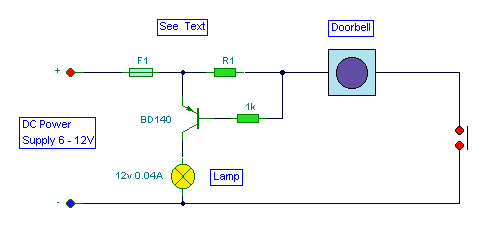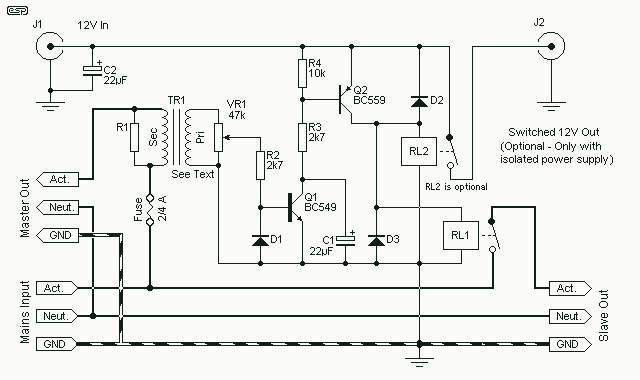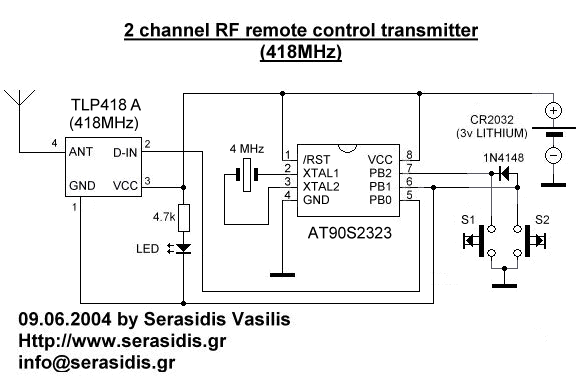
Remote Doorbell Warning Switch

This circuit illuminates a lamp at a remote location when the doorbell switch is activated. It is designed exclusively for use with solenoid-type doorbells; electronic doorbells that produce melodies are not compatible. The circuit addresses the issue of potentially missing the sound of a doorbell while watching television by providing a visual indication. An LED may also serve as an alternative. Connecting a lamp directly in parallel with the doorbell would increase the drain on the doorbell's batteries or transformer. To mitigate this, a series resistor (R1) is connected in series with the doorbell, which reduces current flow and enhances battery life. The value of R1 is selected to develop approximately 0.6 to 0.7 volts across it when the doorbell switch is engaged. A combination of a 22-ohm resistor in parallel with a 50-ohm resistor is used to achieve this voltage drop. This voltage is sufficient to activate a transistor, which in turn illuminates the lamp connected to the collector. Additionally, an electromechanical counter is employed in parallel with the lamp to register each time the switch is pressed.
The circuit comprises a solenoid-type doorbell switch, a series resistor (R1), a transistor, a lamp, and an electromechanical counter. The solenoid-type switch is the initiating component that, when pressed, allows current to flow through R1. The resistor R1 is crucial for limiting the current drawn from the doorbell, thus prolonging the lifespan of the power source. The choice of R1 is critical; it should be selected to ensure that the voltage drop across it is optimal for triggering the transistor without causing excessive power loss.
The transistor acts as a switch that controls the lamp. When the voltage across R1 reaches the specified threshold, the transistor is activated, allowing current to flow from the collector to the emitter, thereby illuminating the lamp. This provides a clear visual indication that someone is at the door, which is especially useful in environments where the doorbell sound may not be heard.
In addition to the lamp, the inclusion of an electromechanical counter serves a dual purpose. It not only tracks the number of times the doorbell is pressed but also enhances the circuit's functionality. The counter is connected in parallel with the lamp, ensuring that it operates independently while still receiving the necessary current to function correctly. This feature can be particularly useful in monitoring visitor frequency or for security purposes.
Overall, this circuit design effectively addresses the limitations of traditional doorbell systems by combining auditory and visual indicators, ensuring that the presence of visitors is communicated effectively, regardless of surrounding noise levels.This circuit will light a lamp at a remote location when the doorbell switch is pressed. This circuit should only be used with the solenoid type doorbells, the electronic type that play tunes will not work here. It is quite easy to miss the sound of a doorbell if you are watching TV, this circuit gets round the problem by providing a visual indic
ation. As an alternative, a LED could also be used. You could just parallel a lamp across the doorbell, but this would mean extra drain from the doorbell batteries or transformer. A series resistor, R1 is wired in series with the doorbell and reduces current flow, thereby increasing battery life.
The value of R1 is chosen so that about 0. 6 to 0. 7 volts is developed across it, when the doorbell switch is pressed. I used a combination of a 22 ohm resistor in parallel with a 50 ohm. The voltage drop across R1 is sufficient to switch on the transistor, the lamp in series with the collector will then illuminate. I also used an electromechanical counter in parallel with the lamp. This registered each time someone pressed the switch. 🔗 External reference
The circuit comprises a solenoid-type doorbell switch, a series resistor (R1), a transistor, a lamp, and an electromechanical counter. The solenoid-type switch is the initiating component that, when pressed, allows current to flow through R1. The resistor R1 is crucial for limiting the current drawn from the doorbell, thus prolonging the lifespan of the power source. The choice of R1 is critical; it should be selected to ensure that the voltage drop across it is optimal for triggering the transistor without causing excessive power loss.
The transistor acts as a switch that controls the lamp. When the voltage across R1 reaches the specified threshold, the transistor is activated, allowing current to flow from the collector to the emitter, thereby illuminating the lamp. This provides a clear visual indication that someone is at the door, which is especially useful in environments where the doorbell sound may not be heard.
In addition to the lamp, the inclusion of an electromechanical counter serves a dual purpose. It not only tracks the number of times the doorbell is pressed but also enhances the circuit's functionality. The counter is connected in parallel with the lamp, ensuring that it operates independently while still receiving the necessary current to function correctly. This feature can be particularly useful in monitoring visitor frequency or for security purposes.
Overall, this circuit design effectively addresses the limitations of traditional doorbell systems by combining auditory and visual indicators, ensuring that the presence of visitors is communicated effectively, regardless of surrounding noise levels.This circuit will light a lamp at a remote location when the doorbell switch is pressed. This circuit should only be used with the solenoid type doorbells, the electronic type that play tunes will not work here. It is quite easy to miss the sound of a doorbell if you are watching TV, this circuit gets round the problem by providing a visual indic
ation. As an alternative, a LED could also be used. You could just parallel a lamp across the doorbell, but this would mean extra drain from the doorbell batteries or transformer. A series resistor, R1 is wired in series with the doorbell and reduces current flow, thereby increasing battery life.
The value of R1 is chosen so that about 0. 6 to 0. 7 volts is developed across it, when the doorbell switch is pressed. I used a combination of a 22 ohm resistor in parallel with a 50 ohm. The voltage drop across R1 is sufficient to switch on the transistor, the lamp in series with the collector will then illuminate. I also used an electromechanical counter in parallel with the lamp. This registered each time someone pressed the switch. 🔗 External reference





